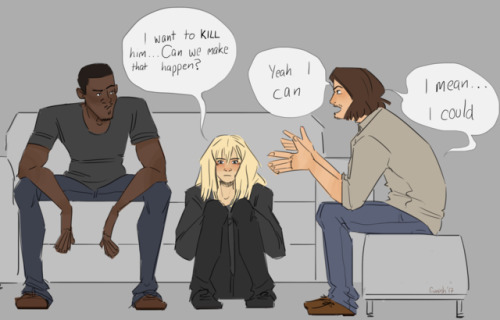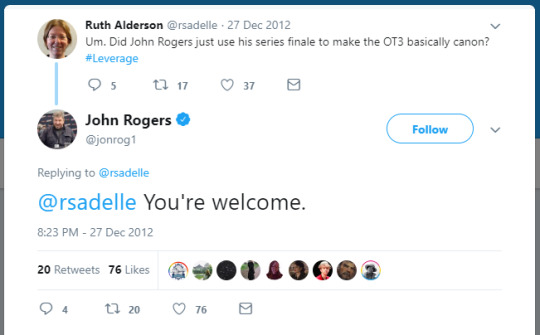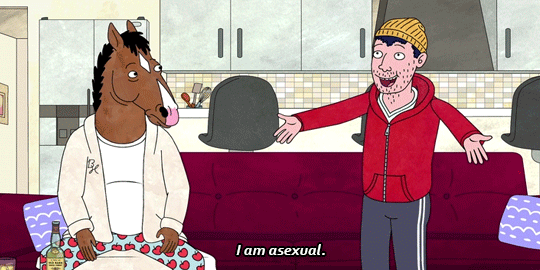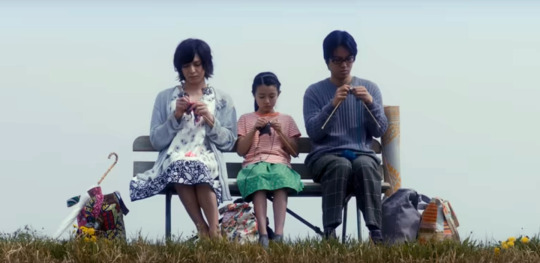A blog for my "Queering the Screen, Queering the Spectator" class for Fall 2019. Header from https://www.redbubble.com/people/karleenaylon/works/29491004-lgbtqia-flag-human?body_color=asphalt&p=t-shirt&size=medium&style=womens
Don't wanna be here? Send us removal request.
Text
Week 13: Leverage Fandom and the OT3
A fandom is a group of people who are a fan of a movie, TV show, a celebrity, or a band. In recent years, fandoms have helped the media create the show they want. One TV show that I would like to share is Leverage, a TV show that aired on TNT from 2008 to 2012. It followed a group of criminals who steal from corrupted people who take advantage of honest citizens. I personally became a fan of the show five years after the finale, but the fandom itself is still very involved in keeping the show alive.

One of the most important parts of the Leverage fandom is the OT3, which consists of Eliot (the hitter), Parker (the thief), and Hardison (the hacker). They are the younger three in the team of five and they all have great chemistry. In the beginning of season five Parker and Hardison (ship name Parkison) revealed that they were dating; the fandom was still deeply passionate about the OT3 being canon, which means making it official in the story.
youtube
This link on the bottom shows a fan asking another fan of the best OT3 episode.
https://letsgostealaleverageblog.tumblr.com/post/160370355259/hi-parkerhardisoneliot-shipper-anon-again-so-I
This fanart on the bottom recreates a scene from Season 2 Episode 13 “The Future Job”, a fake psychic does a cold read on Parker, which revealed to the audience and the rest of the team that she had a brother who got into an accident and blames herself for it. Being socially naïve, she believes that he is an actual psychic; when the team helps her understand that he doesn’t. He was looking at her body language and manipulated her into letting everyone know of a personal story that she never told anyone else. This is the result after she realizes it:

In the finale episode of Leverage, Nate (the mastermind) and Sophie (the grifter) retired since Nate proposed to Sophie (they became a couple by season five as well). In the very last scene, it was revealed that Parker became the mastermind of the team. Some fans asked one of the writers of the show John Rogers on Twitter if they used the finale as a way to make the OT3 canon; he confirmed it.

John Rogers frequently talks to fans through Twitter answering questions about Leverage and other shows that he’s worked on. He gives plenty of behind the scenes stories of the show and tips on how to write good characters and amazing plotlines.
The directors, writers, and cast of Leverage really love the fandom so much. They always thought of the fandom to create a show that we would love so much. There has been numerous times where they have discussed possibly renewing the show. The Leverage fandom would love for this to happen and see the OT3 again.
Website and Photo Links:
https://letsgostealaleverageblog.tumblr.com/post/160370355259/hi-parkerhardisoneliot-shipper-anon-again-so-i
https://www.tumblr.com/tagged/john-rogers
http://www.tv.com/shows/leverage/
https://letsgostealaleverageblog.tumblr.com/post/167814173761
https://letsgostealaleverageblog.tumblr.com/post/179517687102/the-episode-also-includes-one-of-my-favorite
https://sharetv.com/shows/leverage
1 note
·
View note
Text
Week 13: Why we need Asexual Representation in Mainstream Media
Now that it is almost the end of 2019, we have seen so much more representation for different kinds of people in magazines, TV shows, and movies. However, even in this day and age, there are still so many groups of people that don’t get any representation in mainstream media – such as people with disabilities, queer communities, and ethnicities. One group that I would like to see more representation for is the asexual community. Asexual people either do not feel sexual attraction towards anyone or want to be involved in a sexual relationship.

A problem that occurs with the lack of representation in media is that people who are not in that specific community will not understand how they feel in certain situations. If you don’t see different kinds of people, in real life or the media, then you will most likely not be able to have empathy and show kindness to people who are different from you. Since people who are asexual aren’t interested in sex, most people outside of that community will be confused and assume that they “haven’t met the right person yet”.
Another problem with no representation is that people in those communities do not feel like they belong in society or that their feelings are valid. Having different traits than other people can make you feel like an outsider and that you don’t truly belong if you don’t see anyone – in person or on screen – to show that you aren’t alone. Asexual people have a much bigger obstacle in this area since not feeling or wanting anything sexual is not an easy concept for most people to understand.
Any kind of representation that asexual people do have is not very good; they tend to be portrayed as psychopaths, murderers, or just plain weird. There are forums where asexual people complain about how there are no good representations for them in mainstream media, such as “Asexual/Aromantic Representation in Media” on asexuality.org, a website that helps connect other asexual people and has resources on asexuality. A comment on the forum posted by user Laplace stated his frustration on how characters that seemed to have no interest in sex suddenly falls for another character:
"I wish there was more representation that didn't neuter the character's emotions or set them up to somehow getting "cured" of their asexuality. There's already very little representation to begin with and then asexual characters get pigeonholed into certain character archetypes or are completely invalidated altogether." (Laplace, 2016).
In the video below, we see asexual characters in good and bad representations in mainstream media.
youtube
One good representation for asexuality is Todd Chavez from the animated TV show Bojack Horseman. In this show, he talks to his friend about how he doesn’t feel like he’s gay or straight, but rather nothing at all. He is then excited about the fact that he can meet people who are like him and potentially have romantic relationships with other asexual people.

In The Mary Sue article “How Mainstream Media Has Left the Asexual Members of the LGBTQIA+ Community Behind” by Michele Kirichanskaya, she gives a good analogy on how to understand sexual attraction in people: by comparing them to coffee. She explains that in Western culture, there are millions of people who love coffee. They all like it in different ways, such as black, with cream, or sugar. It is also a common drink in restaurants and cafes; it is shown in mainstream media as something people love and is advertised frequently. Asexual people are like those who don’t like coffee.
A song that is popular in the asexual and aromantic community is “Never Been in Love” by Will Jay. Will Jay is a Chinese-American singer who writes many unique songs that are usually inspired by his personal experiences. Although he initially wrote it as a way for him to be ok with the fact that he had never been in a relationship with anyone, it became an anthem for people who have never felt any sexual or romantic feelings for anyone. (By the time he released the music video, he was with his current girlfriend for seven months.) Even though Will himself is not asexual or aromantic, he is grateful that he was able to create a song that made people feel like they were being represented.
youtube
Asexual people barely get any good representation in the mainstream media, whether it is on TV, movies, or webcasts. Most of the bad representation they get show them as people who have no emotion and like to see people suffer for fun. Many asexual people wish to see more characters and people in the media who are more like them, instead of constantly feeling like they are alone. If there was more positive representation for them, then it would be possible for people to understand that not everyone is interested in sex or is attracted to someone in that way.
Website and Photo Links:
https://www.asexuality.org/?q=general.html#ex2
https://www.asexuality.org/en/topic/147876-asexualaromantic-representation-in-media/
https://www.themarysue.com/asexual-representation-failure/
https://www.entitymag.com/demisexual-flag-meaning/
0 notes
Text
Week 11: Transgender Representation in Japanese Dramas and Movies
Growing up I would always watch Japanese TV shows, whether it be when I was living in Japan or watching the TV Japan channel in America. In Japan there are only 12 public TV channels, so there aren’t a whole lot of options in the kinds of programs that are available. TV Japan is a popular channel that offers Japanese TV shows all over the world (although most are broadcasted on the channel a few months to a couple years after they were originally aired), such as the news, movies, dramas, game and variety shows. There are some movies that center on a queer storyline, which I wasn’t too familiar with. I will be talking about a Japanese drama and movie that include transgender characters.

The Japanese drama “Saving My Stupid Youth” (Japanese title “Gomen ne Seishun!”) is about the teachers and students at an all boys Buddhist high school and all girls Catholic high school in the same area of Shizuoka prefecture having to merge due to low enrollment. In episode 8, a student at the all boys school Mamoru Murai, (portrayed by Yuta Koseki) gets caught by his father (who is the chairman of the school) wearing an all girls school uniform. His father impulsively decides to ban the merging of the two schools while the other teachers try to do their best to make the merging work and learn how to navigate Mamoru’s new identity. Mamoru comes out to his father that he has gender dysphoria; he has struggle accepting him due to Japan’s long-held conservative views and his unwillingness to let go of his only son. Meanwhile, with the help of his friends from the all girls school, they were able to visit a former classmate who moved to Tokyo and was able to be dress however she wanted. By the end of the episode Mamoru’s father learns to accept them and lets the schools merge again. Mamoru never goes through surgery during the series, but they are allowed to wear women’s clothes and happier with who they are.

Mamoru is an extremely important character in modern day Japan since there are still many misconceptions about the LGBTQ+ community. There are many terms (mostly outdated and derogatory) to describe people who are gay and transgender. Words such as okama, onabe, and new-half are used to explain someone based on how they present themselves. Okama and onabe are both words not generally used by the youth due to its offensive connotations (the former meaning a feminine male or trans female, the latter meaning masculine female or trans male); new-half is equal to the English derogatory term “shemale”, but the Japanese public is still iffy on whether it is acceptable or not (the word itself mainly describes a trans woman who has male genitalia). Something interesting about the word “new-half” is that “half” itself is commonly used to describe people who are multi-racial. Many slang terms for the LGBTQ+ community are so used to using these words interchangeably and as blanket terms that it is often confusing to people the differences and the core meaning behind them. The audience doesn’t know for sure whether Mamoru is transgender or wants to only wear female clothes, and it could be possible that they don’t know either


One movie that I would like to discuss is “Close-Knit” (Japanese title “Karera ga Honki de Amu Toki wa”), a story about a young girl named Tomo who gets neglected by her mother and starts living with her uncle and his girlfriend (who is transgender female). I have personally never seen this film (I saw the trailer for it on TV Japan months ago but missed it by a few days), but it was well-received and opened the discussion on LGBTQ+ issues in the country. Every time I watch the trailer, I start balling my eyes out since it looks like such an amazing story and I’m so sad that I couldn’t watch it when it was easily available.

The director Naoko Ogigami wanted to bring this story to life ever since she visited America and saw how far behind Japan is on this topic. In the beginning, Tomo was feeling unsure about the whole situation, but over time she starts to accept it since Rinko (Tomo’s uncle’s girlfriend) treats her so well and eventually became the mother she never had. Seeing in the trailer the struggles Rinko goes through with being transgender in Japan and how much she cares about Tomo proves to the audience that love and caring for others has nothing to do with what your genitals are, but about your personality and who you are as a person.
youtube
Both “Saving My Stupid Youth” and “Close-Knit” have made enormous impacts and brought attention to the transgender community. “Saving My Stupid Youth” introduced Mamoru, a character who followed the societal rules of wearing masculine clothes in the beginning while we see over time their transition to become more comfortable with who they are. It is also extremely important that their friends and teachers supported them, as well as seeing their father having to understand where Mamoru is coming from and learning to accept them. From what I’ve read, “Close-Knit” is a pivotal movie of our time as it shows from the entire family’s perspectives on how important it is to accept people who are different from you and have empathy. I’m positive that this movie was very special to many people in Japan since either they or their family members are going through a similar situation. I would love to rewatch “Saving My Stupid Youth” and watch “Close-Knit” sometime in the future.
Work Cited:
https://japanincanada.com/japanese-lgbtq-movies/
http://www.tbs.co.jp/gomenne_tbs/
http://asianwiki.com/Saving_My_Stupid_Youth
https://allabout-japan.com/en/article/5102/
https://www.rottentomatoes.com/m/close_knit/
Photo Creds:
https://matome.naver.jp/odai/2141802034556084601
https://news.aol.jp/2014/10/27/gomenneseisyun/
https://asianmoviepulse.com/2019/06/film-review-close-knit-2017-by-naoko-ogigami-3/
https://france-chebunbun.com/2017/03/01/post-10307/
6 notes
·
View notes